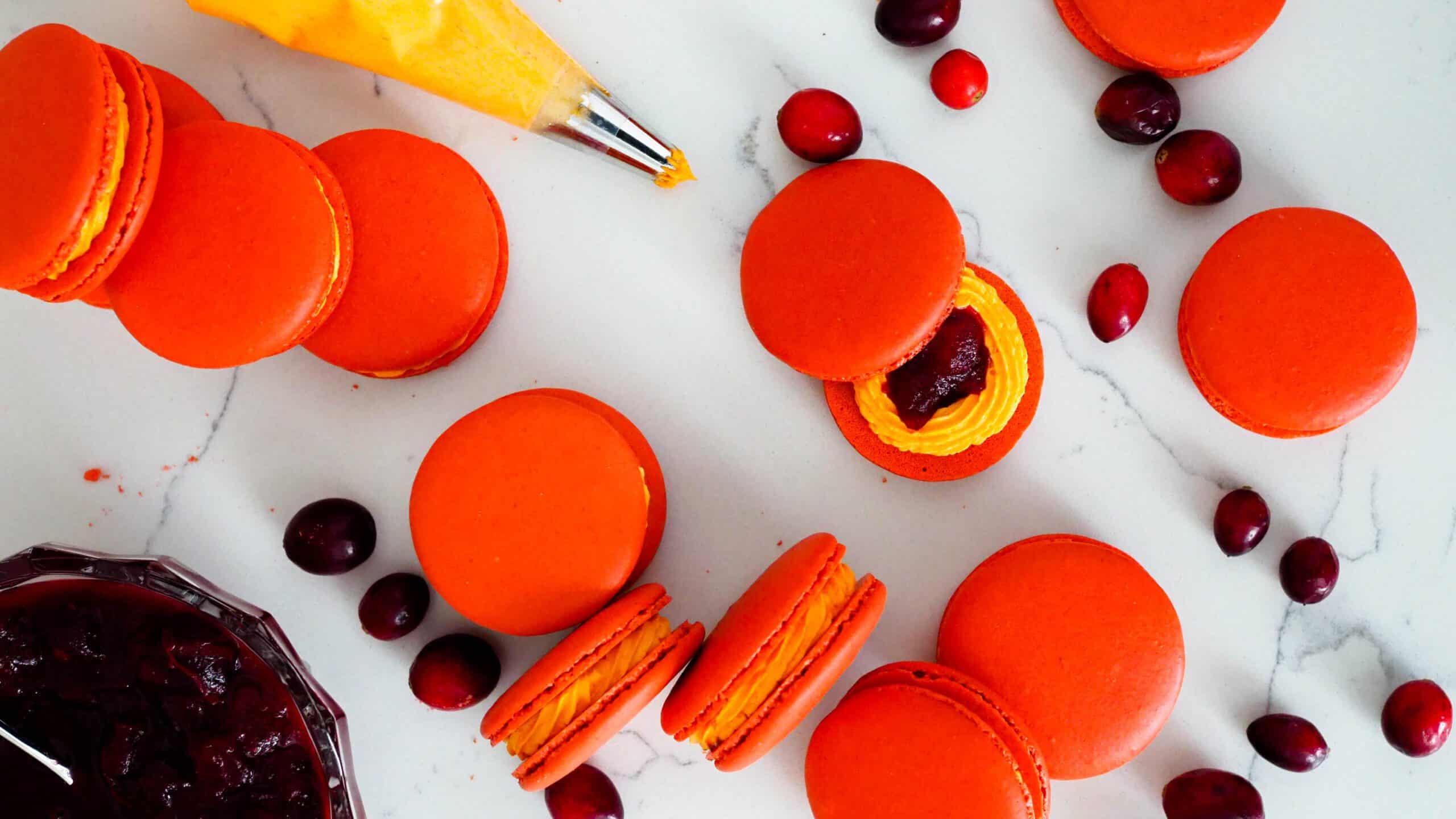Use up leftover cranberry sauce by putting it in cranberry orange macarons! Orange-flavored macaron shells and orange buttercream pair perfectly with cranberry sauce leftover after the holidays. This is the best way to use up leftover cranberry sauce, and even people who aren’t big fans love these macarons.
If you’ve never made macarons before, rest assured! I have plenty of tips and tricks in the body of this post to make you feel confident in the kitchen. I highly recommend reading through (or at least skimming) through the tips. Macarons are finicky creatures, and the more certain you go into making macarons, the better they’ll pop out of your oven. Let’s get started on how to make cranberry orange macarons with leftover cranberry sauce!
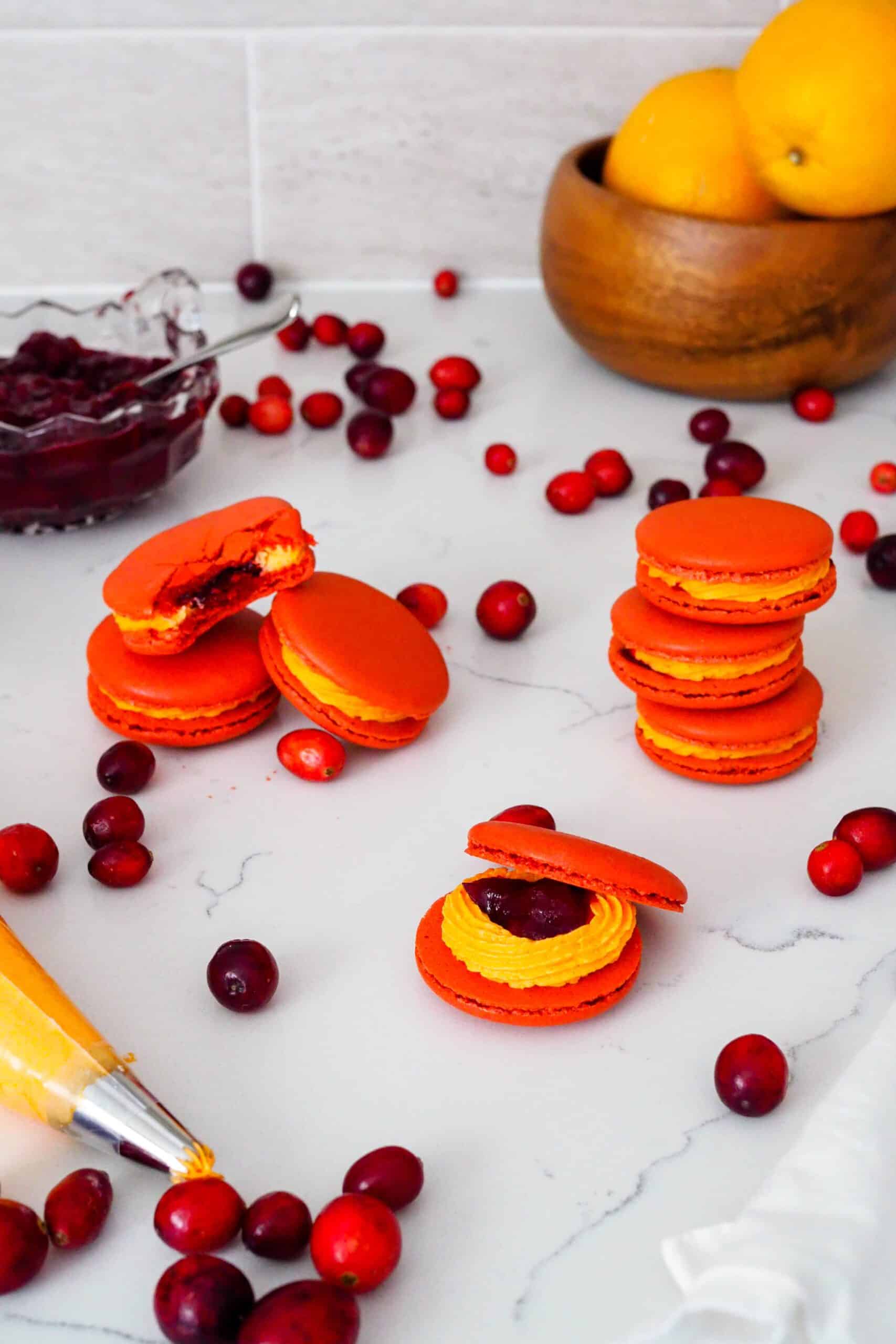
Ingredients for Cranberry Orange Macarons
French macarons require only four ingredients to get right; it’s the fillings that add to the list here! Macarons are made with a simple mix of almond flour and powdered sugar and meringue, from egg whites and granulated sugar. Add orange extract and food coloring for an extra wow factor.
- Egg whites, from four large eggs. For best results, use fresh eggs rather than egg whites in a carton. Those egg whites are pasteurized and may not whip into a meringue.
- Granulated sugar. Sugar helps to stabilize the meringue, allowing you to fold in the almond flour mixture and rest the macarons without worrying about a collapsed meringue.
- Almond flour. Almond flour provides structure for the macaron shell and a nutty flavor.
- Powdered sugar. Powdered sugar helps to thicken the macaron batter and provide structure.
- Orange extract. The easiest way to add flavor to macaron shells is by adding a bit of extract. In this case, the orange extract pairs with the orange zest in the buttercream for a well-rounded, citrusy flavor.
- Red, brown, and orange gel food coloring (optional). Regular food coloring will not work! If you don’t have any gel food coloring, I recommend this kit from Americolor. It has all the colors you’ll need!
- Unsalted butter. Unsalted butter makes up the body of the orange buttercream.
- Milk. This buttercream is much easier to pipe if you thin out with a little bit of milk. I like using oat milk, but you can use whatever you like best.
- An orange. We’ll use the zest from an entire orange, so pick a good one!
- Chilled cranberry sauce. One of the most important ingredients for cranberry orange macarons. I use my cranberry orange sauce recipe, but use whichever cranberry sauce you have on hand. The chunky, homemade kind is my favorite, but jellied cranberry sauce will also work well.

How to Make Cranberry Orange Macarons
The most important thing to remember is that macarons are finicky. Even if they don’t look perfect, they’ll still taste great!
The number one tip I have for making French macaron shells is to be patient. It can take a number of tries to get a perfect batch. My first batch of macarons came out well enough, though there were a few cracked shells. It took me quite a few months, though, to feel confident that each batch I put in the oven would turn out.
Recommended Supplies for Making Macarons
Each oven and home variables vary. I can’t guarantee that these supplies will turn out perfect macs for you. I have used dark baking sheets and aluminum baking sheets and had success in different ovens. With my current oven, a light-colored aluminum baking sheet is essential for turning out macarons.
In my old house and old electric oven, I could use a dark nonstick pan and parchment paper on top of silicon macaron mats with no issues. In my new house and new gas oven, I have to use aluminum pans with silicon macaron mats (affiliate links). Even with my new gas oven, I battle hollow macarons on a regular basis. I recently purchased Breville’s Smart Oven Air Fryer Pro, which is completely electric, and I noticed a difference with just the first batch.
If you are following all the steps and your macarons still aren’t consistent after five batches, I would look into your supplies. Try changing one variable at a time to determine what the problem is.
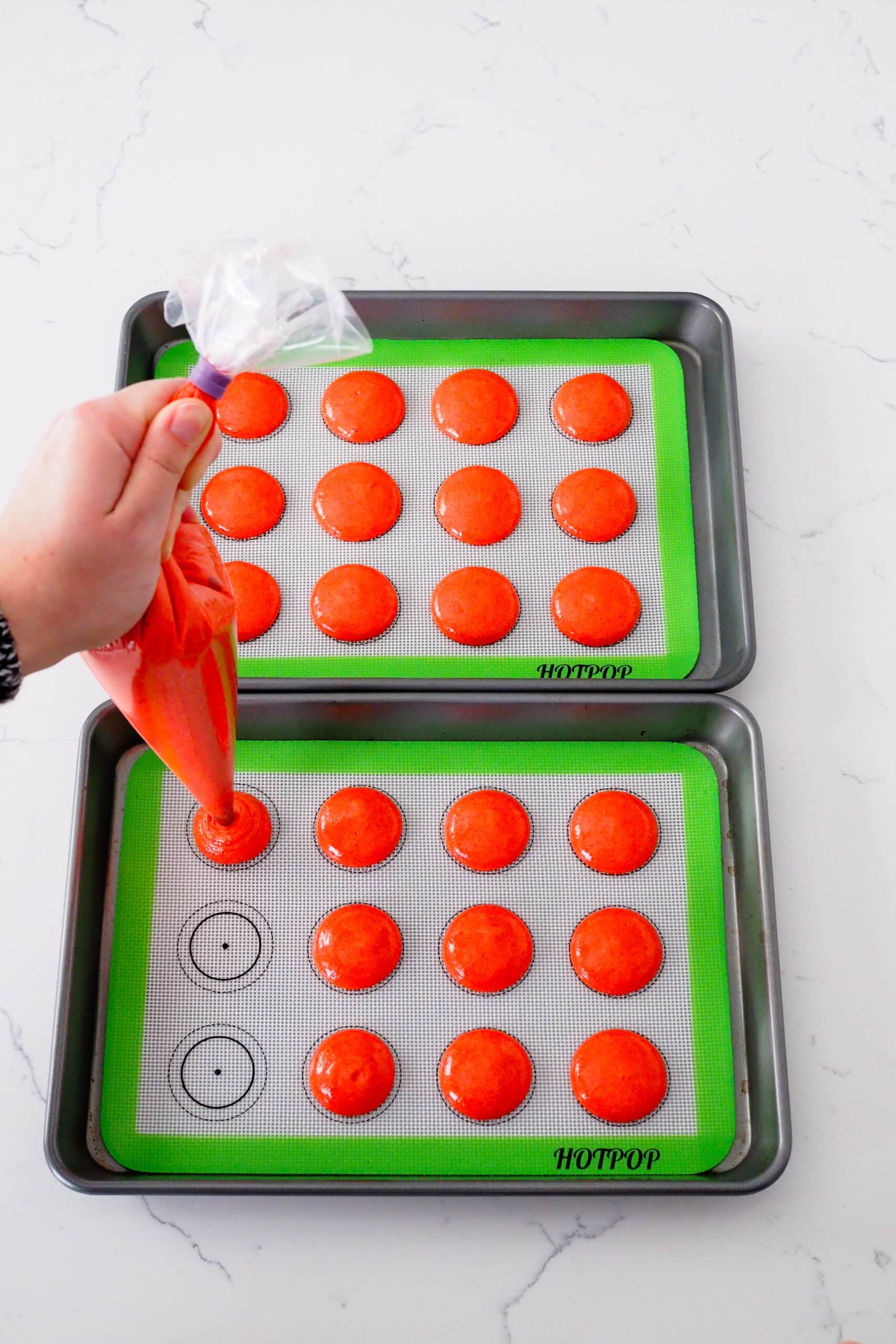
The Perfect Meringue Base
A good meringue is key for a good macaron. French macarons generally call for aged or at least room temperature egg whites—I can use eggs directly from the fridge without a stabilizer because of the way I mix up my meringue.
I adapted this technique from Cenk Sönmezsoy’s The Artful Baker (though he recommends room temperature egg whites). If you’re newer to meringue, I would recommend using room temperature egg whites, as they are a bit more elastic (read: forgiving).
For a perfect French meringue every time, start by whipping the egg whites on low in a stand mixer, just to incorporate. Once the whites begin to foam, increase the speed to medium. The whisk will begin to leave trails in the foam; at that point, sprinkle in the sugar about a teaspoon at a time.
When all the sugar is incorporated, increase the speed to high and whisk until you begin to see the whisk leave deep indents in the meringue (anywhere from three to five minutes).
Test to see if the meringue has stiff peaks by removing the whisk and flipping it upside down. If the meringue stands straight up or curls into itself lightly with a sharp point, stop whisking. (See photo below.) If the point is soft and looks like it has a lot of tiny bubbles in it, whisk for another 10 seconds, then test again.
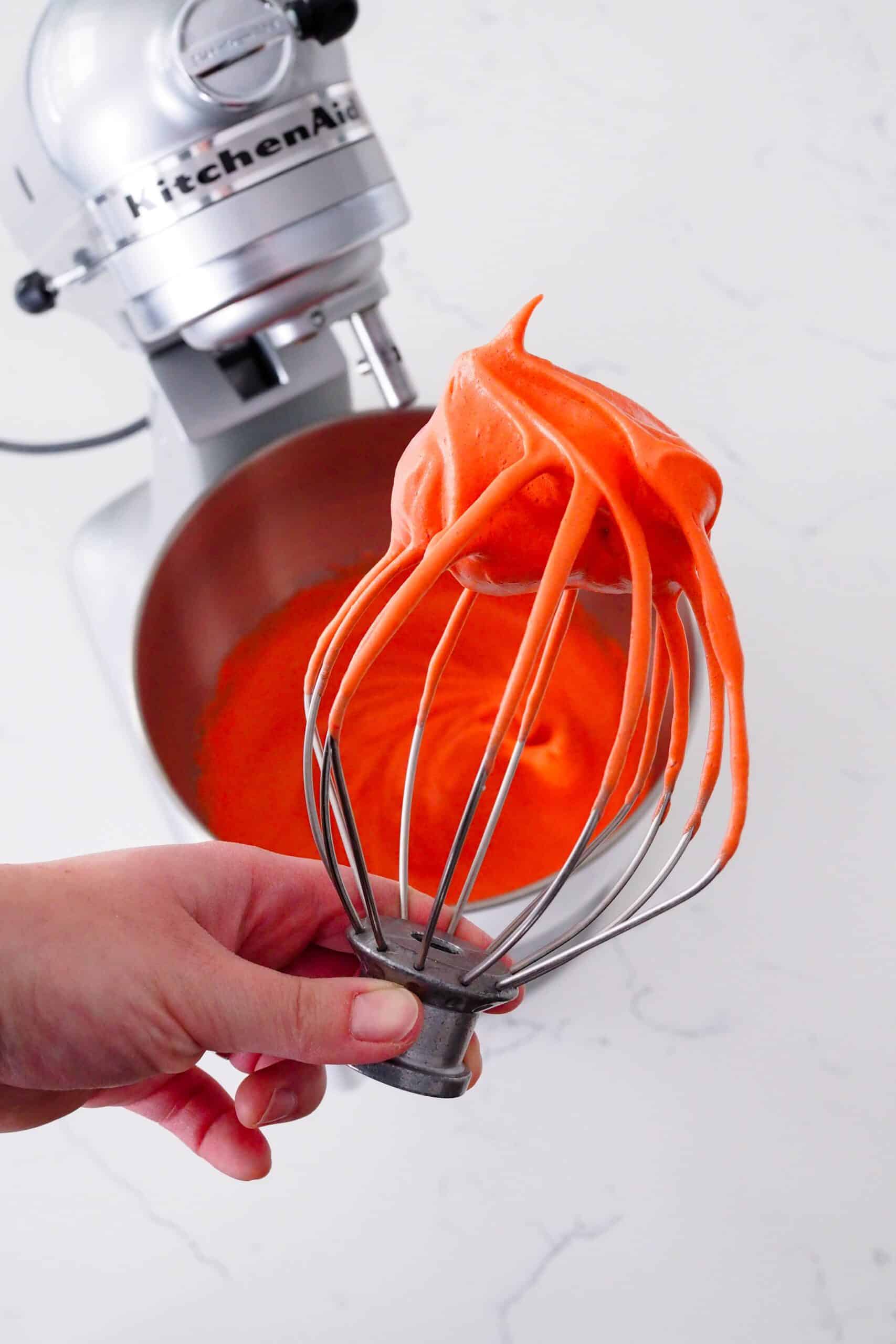
The Perfect Macaron Batter Consistency
Macaron batter needs to be a certain consistency in order to develop feet. The consistency and process is so important that it has its own name: “macaronage.”
The top descriptor I have read for testing macaron batter consistency is it “flows off the spatula like hot lava…” I have never seen hot lava in person, much less seen it being picked up with a spatula. That phrase does not personally help me figure out how to macaronage, which is one of the most important things for beginners to understand.
A more fitting description for the perfect macaron batter consistency is to think of macaronage as a process, not an end result.
Macaronage Is a Process
The egg whites start out as liquid with no air in them. Then you whip in lots of very tiny air bubbles to transform the egg whites into a meringue. You have added so much air into the egg whites that now they essentially function as a solid instead of a liquid.
Then, you fold in almond flour and powdered sugar. As you fold the batter with a spatula, you are knocking the air out of the meringue. That helps to transform our previously solid meringue back into a liquid batter. The more folds you give the batter, the more liquid the batter becomes. (My husband says this is called viscosity, but that’s a bit technical.)
The perfect consistency of macaron batter will look grainy as it flows off the spatula in one long, stacking ribbon. Then, it begin to look shiny and absorb back into the rest of the batter within 10-15 seconds.
If your batter takes more than 15 seconds to absorb, you need to knock more air out of the meringue. Too much air in the macarons will make them crack in the oven.
If your batter takes closer to 5 seconds to absorb, it’s likely overmixed; however, it will probably still turn out decent macarons. Unfortunately, if your batter absorbs immediately, there is not enough air left in the meringue to form proper macarons. I recommend starting over.
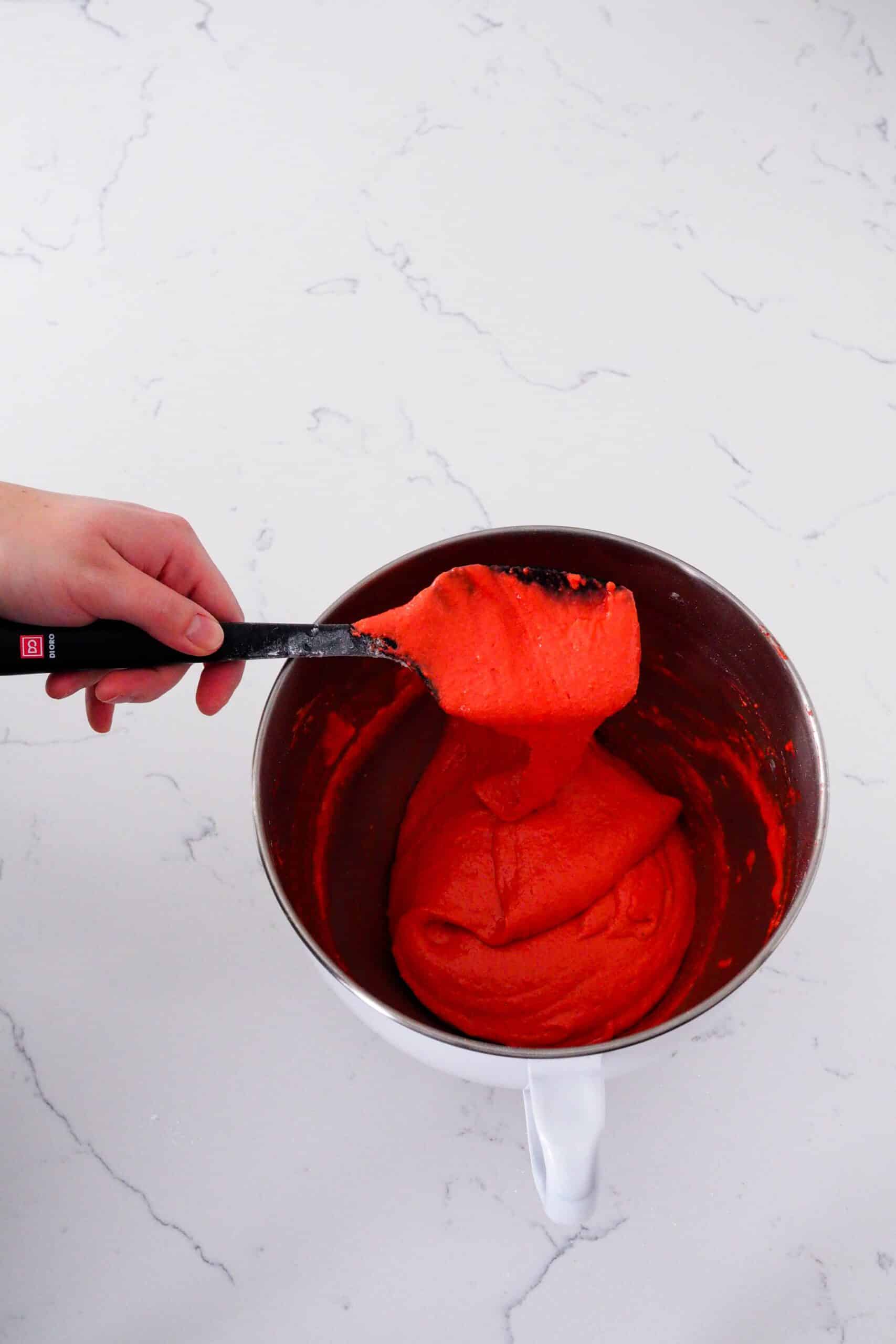
Do I Really Need to Weigh the Ingredients for Macarons?
YES. If there was ever a case for all-caps, this is it. I typically include both volumetric (cups) and mass (weight) measurements on my recipes, but because macarons are so finicky, I have only included mass measurements. Yes, this requires a kitchen scale, but it is worth it to get perfect macarons every time.
Kitchen scales are relatively inexpensive as far as minor appliances go, and they will last you forever. I have this kitchen scale from OXO and love it.
Quick Tips for Prepping Orange Buttercream
This orange buttercream comes together simply and quickly with just a few ingredients.
I like to beat my room temperature butter first, either in the bowl of your stand mixer or a medium bowl. This helps the powdered sugar incorporate into it best.
Then, add your powdered sugar a little bit at a time, beating after each addition, to prevent clouds of powdered sugar from hovering over your kitchen.
Remove the bowl from the stand mixer base. Use a Microplane or zester to zest the orange directly over the bowl. Make sure to only zest the orange of the orange off. The white pith can be bitter, so it’s best to leave that on the rind.
If you want a very strong orange flavor, you can add half a teaspoon of orange extract. For the bright orange color, add 2-4 drops of orange gel food coloring.
Finally, transfer the buttercream into a piping bag fitted with the tip of your choosing. I used Wilton 32, but you may use whatever tip you prefer!
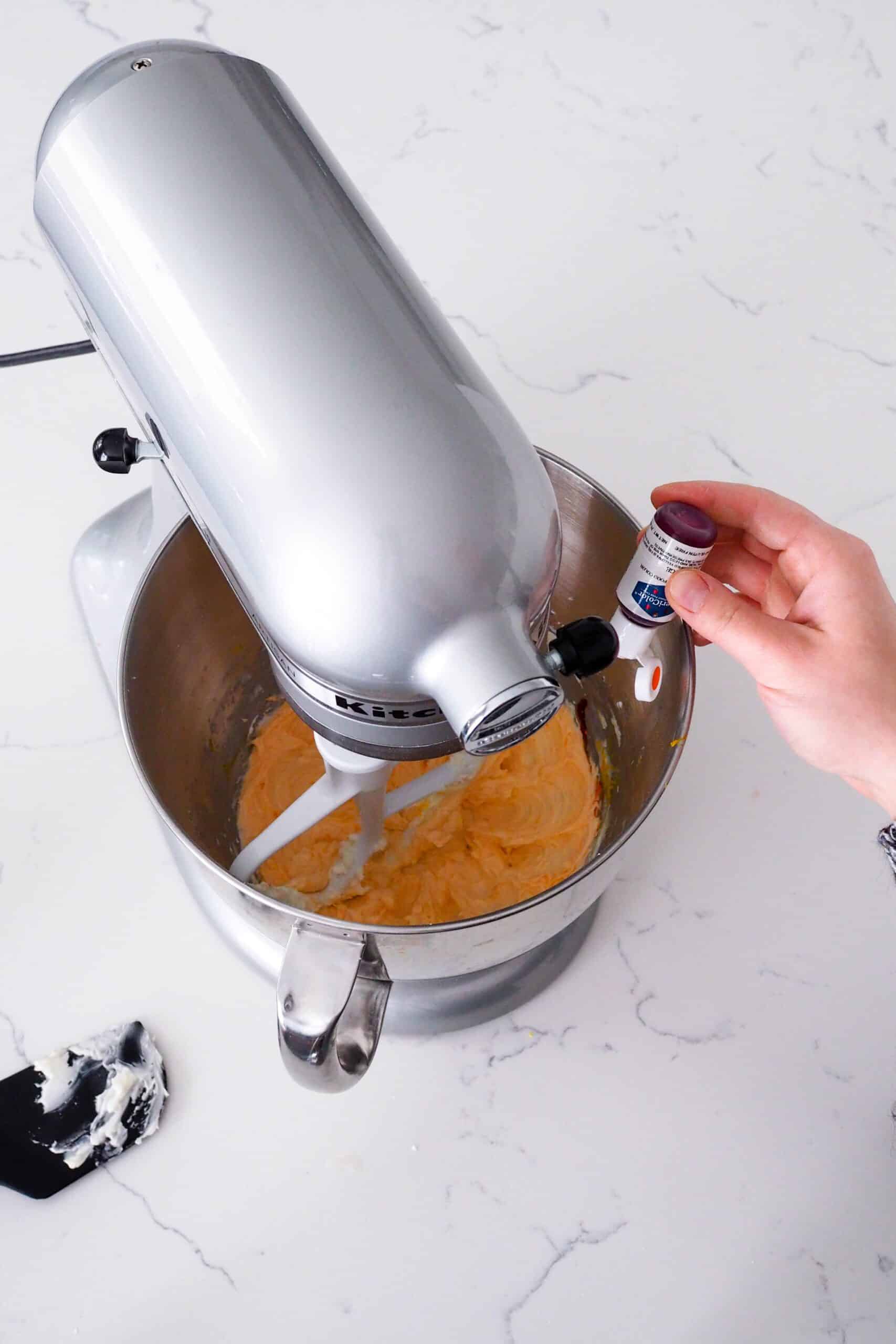
How to Fill Cranberry Orange Macarons
Even experienced macaron makers have a hard time getting each and every macaron to be exactly the same size. Those little differences add up when you pair macarons together. I always recommend pairing similarly-sized macarons together before you start filling them. This ensures all of your macarons will have a mate.
On a macaron shell with the flat bottom facing up, pipe a ring of orange buttercream. This will form a border to hold in the cranberry sauce. Repeat with the remaining macarons.
Then, using a small coffee spoon or piping bag, fill the centers of the buttercream rings with about ½-¾ teaspoon of cranberry sauce. Place the matching macaron shell on top and pressing light to form a nice seal. Do your best to keep the cranberry sauce inside of the frosting; otherwise, some may leak out.
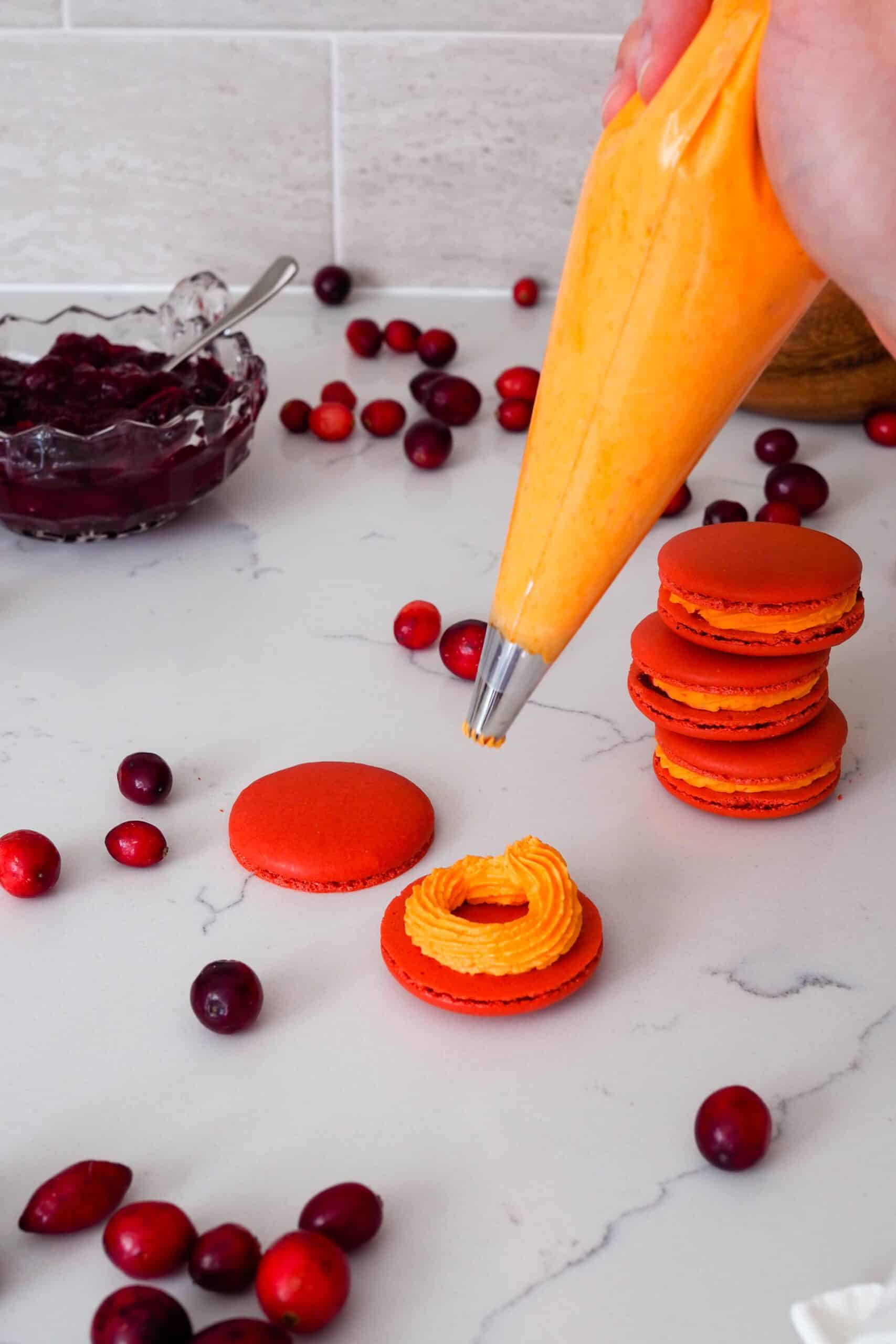
Where Do I Store Macarons?
Macarons should be kept in the fridge. They will stay fresh for about a week, depending on the filling.
Other Recipes You May Enjoy
If you run out of cranberry sauce, it’s easy enough to make another batch! My cranberry orange sauce is always the talk of the table at holidays and a big family favorite.
Looking for more macaron flavors for the holiday season? Pumpkin spice macarons are my dad’s favorite, and for good reason: They’re made with real pumpkin, cream cheese, and pumpkin pie spice for a deliciously seasonal cookie.
Warm up by a fire with family and my salted caramel hot chocolate. It’s rich without using melted chocolate and pairs wonderfully with homemade vanilla marshmallows.
Dish Cleanup: Gonna Take a While
I rate my recipe cleanups on a scale of 1 to 5. 1 is only a handful of dishes, and 5 is everything including the kitchen sink.
My cranberry orange macarons recipe has a cleanup rating of a 4. This is standard for many macaron recipes, as they require one mixing bowl for the batter and one for the buttercream, along with mixer attachments and spatulas. You can easily cut down on the dishes by combining a few ingredients into the same bowl. As long as the ingredients are added to the recipe at the same time, there’s no need to wash three little bowls when one would do.
Cranberry Orange Macarons Recipe
Cranberry Orange Macarons

The best way to use up leftover cranberry sauce is to put it in macarons! Orange-flavored macaron shells and buttercream pair perfectly with cranberry sauce leftover after the holidays.
Ingredients
For the Macaron Shells
- 120g egg whites, from four large eggs
- 50g granulated sugar
- 120g almond flour
- 200g powdered sugar
- ½ teaspoon orange extract
- 10-15 drops red gel food coloring (optional)
- 1 drop brown gel food coloring (optional)
For the Orange Buttercream
- 4 Tablespoons unsalted butter (56g), at room temperature
- 1 cup powdered sugar (120g)
- 1 Tablespoon milk
- One medium orange
- ½ teaspoon orange extract (optional)
- 2-3 drops orange gel food coloring (optional)
For the Cranberry Filling
Instructions
Making the Macarons
- Prepare two baking sheets with macaron silpats or parchment paper. Prepare a piping bag fitted with a round tip (I use Wilton #12 or Ateco 808) and set aside.
- Process powdered sugar and almond flour together in a food processor or blender for a superfine consistency. This is necessary for perfectly smooth shells. Set aside.
- Separate the eggs. Place egg whites in the bowl of a stand mixer fitted with the whisk attachment and mix on 2 (or low) until frothy. Increase speed to 4 (medium-low). Once the whisk begins leaving a trail in the egg whites, sprinkle in the sugar about a teaspoon at a time. Once all the sugar is incorporated, increase speed to 6 (medium) and whisk until stiff peaks form.
- Add in the orange extract and gel food coloring if desired. Whisk on high for just a couple of seconds to fully incorporate.
- Remove the bowl from the stand mixer and pour half of the almond flour mixture into the meringue. Fold together until fully incorporated, scraping the sides and bottom of the bowl. Add in the remaining almond flour mixture and fold together. The mixture will be thick, but as you continue folding, it will lose some air and thin out. Continue folding and pressing the batter into the sides of the bowl until the batter is the correct consistency (covered in the next step).
- To test the consistency, scoop the batter up, and let it flow back into the bowl. Continue folding until the mixture flows in one solid ribbon off the spatula. It should look a bit grainy as it flows off the spatula, then dissolve back into the batter in 10-15 seconds and look glossy instead of grainy.
- Pour the batter into the prepared piping bag. Holding the bag at a 90° angle to the pan, gently squeeze out the macaron batter into lumps about 1-1.5" in diameter. They will spread as they settle.
- Once piped, pick up the pan with one hand and bang the heel of your other hand against it in various locations under the macarons until you see air bubbles rise from the bottoms of the shells. Alternatively, bang the pan against the counter a few times. Use a toothpick to pop any remaining bubbles for a perfectly smooth top. Notice how shiny the surface looks now; it will dull as the macarons rest.
- Set the macarons aside in a well-ventilated area to dry for about 20-30 minutes. On particularly humid days, this may take up to an hour.
- While the macarons are drying, preheat the oven to 320°F. The macarons are ready to go in the oven when the tops are no longer reflective and you can lightly touch the top of a macaron without it leaving residue on your finger.
Baking the Macarons
- Once the macarons are dry, bake one tray at a time in the center rack for 15-17 minutes or until the macaron is set. Test to see if the macarons are set: Try to gently wiggle a macaron back and forth from the center of the pan with your thumb and forefinger. If the center moves at all, put the tray back in the oven for another minute or two until the center of the macaron is set and does not move when prompted.
- Let each tray cool completely before removing the macarons from the mats, about 10 minutes.
Making the Orange Buttercream
- Cream the butter in a medium bowl or the bowl of your stand mixer.
- Add in the powdered sugar half a cup at a time, pulsing after each addition to prevent powdered sugar clouds.
- Drizzle the milk into the mixture, then beat for one minute to fully combine.
- Remove the bowl from the base of the stand mixer and zest your orange directly into the bowl. For an extra burst of flavor, add the orange extract.
- Add 2-3 drops of orange gel food coloring, if using.
- Beat together for another minute to combine, then transfer into a piping bag prepared with the piping tip of your choice. I used Wilton 32.
Assembling the Macarons
- Pair similarly sized macarons together and line them up with one side face up and one side face down.
- On a macaron shell with the flat bottom facing up, pipe a ring of orange buttercream to make a border that will hold in the cranberry sauce. Repeat with the rest of the macarons.
- Using a small coffee spoon or piping bag, fill the centers of the buttercream rings with about ½-¾ teaspoon of cranberry sauce. Place the matching macaron shell on top and twist while pressing lightly to form a nice seal.
- The macaron shells will soften and the flavors will develop after maturing in the fridge for one day, though you may eat them any time you'd prefer after assembly.
Notes
Store in the fridge in an airtight container for up to a week for maximum freshness.
Recommended Products
As an Amazon Associate and member of other affiliate programs, I earn from qualifying purchases.
-
Nordic Ware Natural Aluminum Commercial Baker's Half Sheet, 2-Pack, Silver
-
HOTPOP Set of 4 Reusable Silicone Macaron Baking Mats 0.75mm (2 Half Sheets and 2 Quarter Sheets), Non Stick Silicone Liner for Bake Pans and Rolling for Macaron, Pastry, Cookie, Bun, Brioche, Bread
-
Food Coloring AmeriColor Student Kit, 12 .75 Ounce Bottles Soft Gel Paste Colors
-
DI ORO Silicone Spatula Set
-
Microplane Master Series Wood Handle Stainless Steel Zester Grater
-
KitchenAid KSM150PSCU Artisan Series 5-Qt. Stand Mixer with Pouring Shield - Contour Silver
Nutrition Information:
Yield:
30Serving Size:
1 filled macaronAmount Per Serving: Calories: 108Total Fat: 4gSaturated Fat: 1gTrans Fat: 0gUnsaturated Fat: 3gCholesterol: 29mgSodium: 17mgCarbohydrates: 16gFiber: 1gSugar: 14gProtein: 2g
The nutrition facts are estimated and may vary based on specific ingredients used.
Thanks for trying out my recipe! Please consider rating this recipe so others find it, too.
I’d love to see how your recipe turns out: Take a photo and tag me on Instagram @floralapronblog to share with me, or use the hashtag #floralapronbakes.
This post contains affiliate links. If you click through and make a purchase, I may receive a small commission at no cost to you. Thank you for helping to support The Floral Apron!

